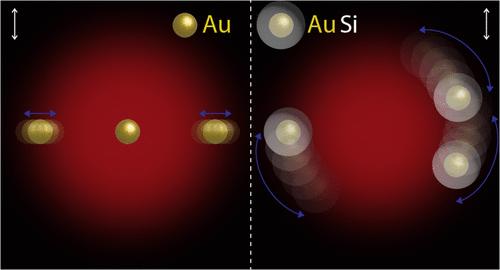Our official English website, www.x-mol.net, welcomes your
feedback! (Note: you will need to create a separate account there.)
Unconventional Optical Matter of Hybrid Metal–Dielectric Nanoparticles at Interfaces
ACS Nano ( IF 15.8 ) Pub Date : 2024-11-18 , DOI: 10.1021/acsnano.4c10418 Boris Louis, Chih-Hao Huang, Marc Melendez, Ana Sánchez-Iglesias, Jorge Olmos-Trigo, Sudipta Seth, Susana Rocha, Rafael Delgado-Buscalioni, Luis M. Liz-Marzán, Manuel I. Marqués, Hiroshi Masuhara, Johan Hofkens, Roger Bresolí-Obach
ACS Nano ( IF 15.8 ) Pub Date : 2024-11-18 , DOI: 10.1021/acsnano.4c10418 Boris Louis, Chih-Hao Huang, Marc Melendez, Ana Sánchez-Iglesias, Jorge Olmos-Trigo, Sudipta Seth, Susana Rocha, Rafael Delgado-Buscalioni, Luis M. Liz-Marzán, Manuel I. Marqués, Hiroshi Masuhara, Johan Hofkens, Roger Bresolí-Obach

|
Optical matter, a transient arrangement formed by the interaction of light with micro/nanoscale objects, provides responsive and highly tunable materials that allow for controlling and manipulating light and/or matter. A combined experimental and theoretical exploration of optical matter is essential to advance our understanding of the phenomenon and potentially design applications. Most studies have focused on nanoparticles composed of a single material (either metallic or dielectric), representing two extreme regimes, one where the gradient force (dielectric) and one where the scattering force (metallic) dominates. To understand their role, it is important to investigate hybrid materials with different metallic-to-dielectric ratios. Here, we combine numerical calculations and experiments on hybrid metal–dielectric core–shell particles (200 nm gold spheres coated with silica shells with thicknesses ranging from 0 to 100 nm). We reveal how silica shell thickness critically influences the essential properties of optical binding, such as interparticle distance, reducing it below the anticipated optical binding length. Notably, for silica shells thicker than 50 nm, we observed a transition from a linear arrangement perpendicular to polarization to a hexagonal arrangement accompanied by a circular motion. Further, the dynamic swarming assembly changes from the conventional dumbbell-shaped to lobe-like morphologies. These phenomena, confirmed by both experimental observations and dynamic numerical calculations, demonstrate the complex dynamics of optical matter and underscore the potential for tuning its properties for applications.
中文翻译:

界面处杂化金属-介电纳米粒子的非常规光学物质
光学物质是由光与微/纳米级物体相互作用形成的瞬态排列,提供响应迅速且高度可调的材料,允许控制和操纵光和/或物质。对光学物质的实验和理论探索对于促进我们对这种现象的理解和潜在的设计应用至关重要。大多数研究都集中在由单一材料(金属或电介质)组成的纳米颗粒上,代表两种极端状态,一种是梯度力(电介质)和散射力(金属)占主导地位。要了解它们的作用,研究具有不同金属介电比的混合材料非常重要。在这里,我们结合了混合金属-介电核-壳颗粒(200 nm 金球涂有厚度为 0 到 100 nm 的二氧化硅壳)的数值计算和实验。我们揭示了二氧化硅壳厚度如何关键地影响光束缚的基本特性,例如粒子间距离,将其降低到预期的光束缚长度以下。值得注意的是,对于厚度超过 50 nm 的二氧化硅壳,我们观察到从垂直于极化的线性排列转变为伴有圆周运动的六边形排列。此外,动态蜂群组件从传统的哑铃形形态转变为叶状形态。这些现象通过实验观察和动态数值计算得到证实,证明了光学物质的复杂动力学,并强调了调整其特性以用于应用的潜力。
更新日期:2024-11-18
中文翻译:

界面处杂化金属-介电纳米粒子的非常规光学物质
光学物质是由光与微/纳米级物体相互作用形成的瞬态排列,提供响应迅速且高度可调的材料,允许控制和操纵光和/或物质。对光学物质的实验和理论探索对于促进我们对这种现象的理解和潜在的设计应用至关重要。大多数研究都集中在由单一材料(金属或电介质)组成的纳米颗粒上,代表两种极端状态,一种是梯度力(电介质)和散射力(金属)占主导地位。要了解它们的作用,研究具有不同金属介电比的混合材料非常重要。在这里,我们结合了混合金属-介电核-壳颗粒(200 nm 金球涂有厚度为 0 到 100 nm 的二氧化硅壳)的数值计算和实验。我们揭示了二氧化硅壳厚度如何关键地影响光束缚的基本特性,例如粒子间距离,将其降低到预期的光束缚长度以下。值得注意的是,对于厚度超过 50 nm 的二氧化硅壳,我们观察到从垂直于极化的线性排列转变为伴有圆周运动的六边形排列。此外,动态蜂群组件从传统的哑铃形形态转变为叶状形态。这些现象通过实验观察和动态数值计算得到证实,证明了光学物质的复杂动力学,并强调了调整其特性以用于应用的潜力。


















































 京公网安备 11010802027423号
京公网安备 11010802027423号